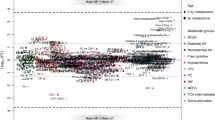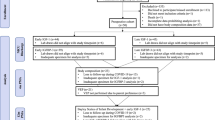Abstract
Background
Progranulin (PGRN) displays pleiotropic biological functions and has been proposed as a biomarker for metabolic diseases. We longitudinally assessed PGRN concentrations in infants born appropriate (AGA) or small for gestational age (SGA), the latter being at risk for obesity and type 2 diabetes, especially if they experience an excessive postnatal catch-up in weight and are formula-fed (FF).
Methods
The study population consisted of 183 infants who were exclusively breast-fed [(BF), AGA, n = 66; SGA, n = 40], or FF (AGA, n = 31; SGA, n = 46) over the first 4 months. Assessments included auxology, fasting glucose, insulin, IGF-1, high-molecular-weight adiponectin, PGRN and body composition (by DXA), at birth, and at age 4 and 12 months.
Results
PGRN levels were low at birth and unaffected by prenatal growth. PGRN increased at 4 and 12 months, although to a lesser extent in SGA infants, and was unrelated to the mode of feeding. PGRN correlated with markers of adiposity, inflammation and insulin resistance in both AGA and SGA infants, especially in those FF.
Conclusions
The attenuated increase of PGRN levels in SGA infants over the first year of life, along with the association to markers of unhealthy metabolic profile, might point to a role of PGRN in future disease risks.
Impact
-
Progranulin (PGRN) displays pleiotropic biological functions and has been proposed as a biomarker for metabolic diseases.
-
In healthy infants, PGRN concentrations are low at birth and experience a significant and progressive increase up to age 12 months, which is less marked in infants born small for gestational age (SGA) and is unrelated to the mode of feeding.
-
Circulating PGRN is related to markers of adiposity, inflammation, and insulin sensitivity, especially in formula-fed SGA infants.
-
PGRN may play a role in the metabolic adaptations of SGA infants during early life, potentially contributing to the risk for obesity and type 2 diabetes in this population.
This is a preview of subscription content, access via your institution
Access options
Subscribe to this journal
Receive 14 print issues and online access
$259.00 per year
only $18.50 per issue
Buy this article
- Purchase on Springer Link
- Instant access to full article PDF
Prices may be subject to local taxes which are calculated during checkout

Similar content being viewed by others
Data availability
The datasets generated during and/or analyzed during the current study are available from the corresponding author on reasonable request.
References
Bateman, A., Cheung, S. T. & Bennett, H. P. J. A brief overview of progranulin in health and disease. Methods Mol. Biol. 1806, 3–15 (2018).
Rhinn, H., Tatton, N., McCaughey, S., Kurnellas, M. & Rosenthal, A. Progranulin as a therapeutic target in neurodegenerative diseases. Trends Pharmacol. Sci. 43, 641–652 (2022).
Fu, W., Hettinghouse, A. & Liu, C. J. In vitro physical and functional interaction assays to examine the binding of progranulin derivative Atsttrin to TNFR2 and its Anti-TNFα activity. Methods Mol. Biol. 2248, 109–119 (2021).
Korolczuk, A. & Bełtowski, J. Progranulin, a new adipokine at the crossroads of metabolic syndrome, diabetes, dyslipidemia and hypertension. Curr. Pharm. Des. 23, 1533–1539 (2017).
Abella, V. et al. Progranulin as a biomarker and potential therapeutic agent. Drug Discov. Today 22, 1557–1564 (2017).
Matsubara, T. et al. PGRN is a key adipokine mediating high fat diet-induced insulin resistance and obesity through IL-6 in adipose tissue. Cell Metab. 15, 38–50 (2012).
Li, H. et al. Administration of progranulin (PGRN) triggers ER stress and impairs insulin sensitivity via PERK-eIF2α-dependent manner. Cell Cycle 14, 1893–1907 (2015).
Nguyen, A. D., Nguyen, T. A., Martens, L. H., Mitic, L. L. & Farese, R. V. Jr. Progranulin: at the interface of neurodegenerative and metabolic diseases. Trends Endocrinol. Metab. 24, 597–606 (2013).
Qu, H., Deng, H. & Hu, Z. Plasma progranulin concentrations are increased in patients with type 2 diabetes and obesity and correlated with insulin resistance. Mediators Inflamm. 2013, 360190 (2013).
Tanaka, Y., Takahashi, T. & Tamori, Y. Circulating progranulin level is associated with visceral fat and elevated liver enzymes: significance of serum progranulin as a useful marker for liver dysfunction. Endocr. J. 61, 1191–1196 (2014).
Blüher, M. et al. Two patterns of adipokine and other biomarker dynamics in a long-term weight loss intervention. Diabetes Care 35, 342–349 (2012).
Alissa, E. M., Sutaih, R. H., Kamfar, H. Z., Alagha, A. E. & Marzouki, Z. M. Serum progranulin levels in relation to insulin resistance in childhood obesity. J. Pediatr. Endocrinol. Metab. 30, 1251–1256 (2017).
Daxer, J. et al. Nocturnal levels of chemerin and progranulin in adolescents: influence of sex, body mass index, glucose metabolism and sleep. J. Pediatr. Endocrinol. Metab. 30, 57–61 (2017).
Niklowitz, P., Rothermel, J., Lass, N., Barth, A. & Reinehr, T. Is there a link between progranulin, obesity, and parameters of the metabolic syndrome in children? Findings from a longitudinal intervention study. Pediatr. Diabetes 20, 1047–1055 (2019).
Waluga-Kozlowska, E. et al. Progranulin and chemerin plasma level in obese patients with type 2 diabetes treated with a long-acting insulin analogue and premixed insulin analogue. J. Physiol. Pharmacol. 72, https://doi.org/10.26402/jpp.2021.6.07 (2021).
Yilmaz, Y. et al. Serum progranulin as an independent marker of liver fibrosis in patients with biopsy-proven nonalcoholic fatty liver disease. Dis. Markers 31, 205–210 (2011).
Serdar Açıkgöz, A. et al. Evaluation of maternal serum progranulin levels in normotensive pregnancies, and pregnancies with early- and late-onset preeclampsia. J. Matern. Fetal Neonatal Med. 29, 2658–2664 (2016).
Nobili, V., Alisi, A., Panera, N. & Agostoni, C. Low birth weight and catch-up-growth associated with metabolic syndrome: a ten-year systematic review. Pediatr. Endocrinol. Rev. 6, 241–247 (2008).
Leunissen, R. W., Kerkhof, G. F., Stijnen, T. & Hokken-Koelega, A. Timing and tempo of first-year rapid growth in relation to cardiovascular and metabolic risk profile in early adulthood. JAMA 301, 2234–2242 (2009).
Nakano, Y. Adult-onset diseases in low birth weight infants: association with adipose tissue maldevelopment. J. Atheroscler. Thromb. 27, 397–405 (2020).
de Zegher, F. et al. Breast-feeding vs formula-feeding for infants born small-for-gestational-age: divergent effects on fat mass and on circulating IGF-I and high-molecular-weight adiponectin in late infancy. J. Clin. Endocrinol. Metab. 98, 1242–1247 (2013).
de Zegher, F. et al. Body composition and circulating high-molecular-weight adiponectin and IGF-I in infants born small for gestational age: breast- versus formula-feeding. Diabetes 61, 1969–1973 (2012).
Díaz, M. et al. Placental and cord blood methylation of genes involved in energy homeostasis: association with fetal growth and neonatal body composition. Diabetes 66, 779–784 (2017).
Díaz, M., Garde, E., Lopez-Bermejo, A., de Zegher, F. & Ibañez, L. Differential DNA methylation profile in infants born small-for-gestational-age: association with markers of adiposity and insulin resistance from birth to age 24 months. BMJ Open Diabetes Res. Care 8, e001402 (2013).
Díaz, M. et al. Circulating GLP-1 in infants born small-for-gestational-age: breast-feeding versus formula-feeding. Int. J. Obes. 39, 1501–1503 (2015).
Díaz, M., García-Beltran, C., López-Bermejo, A., de Zegher, F. & Ibáñez, L. GLP-1 and IGF-I levels are elevated in late infancy in low birth weight infants, independently of GLP-1 receptor polymorphisms and neonatal nutrition. Int. J. Obes. 42, 915–918 (2018).
Díaz, M. et al. Circulating growth-and-differentiation factor-15 in early life: relation to prenatal and postnatal growth and adiposity measurements. Pediatr. Res. 87, 897–902 (2020).
Konopka, J., Richbourgh, B. & Liu, C. The role of PGRN in musculoskeletal development and disease. Front. Biosci. 19, 662–671 (2014).
Gow, D. J., Sester, D. P. & Hume, D. A. CSF-1, IGF-1, and the control of postnatal growth and development. J. Leukoc. Biol. 88, 475–481 (2010).
Hu, S. Y., Tai, C. C., Li, Y. H. & Wu, J. L. Progranulin compensates for blocked IGF-1 signaling to promote myotube hypertrophy in C2C12 myoblasts via the PI3K/Akt/mTOR pathway. FEBS Lett. 586, 3485–3492 (2012).
Noguchi, T. et al. Progranulin plays crucial roles in preserving bone mass by inhibiting TNF-α-induced osteoclastogenesis and promoting osteoblastic differentiation in mice. Biochem. Biophys. Res. Commun. 465, 638–643 (2015).
Wang, N., Zhang, J. & Yang, J.X. Growth factor progranulin blocks tumor necrosis factor-α-mediated inhibition of osteoblast differentiation. Genet. Mol. Res. 15, https://doi.org/10.4238/gmr.15038126 (2016).
Zhao, Y. P., Tian, Q. Y., Frenkel, S. & Liu, C. J. The promotion of bone healing by progranulin, a downstream molecule of BMP-2, through interacting with TNF/TNFR signaling. Biomaterials 34, 6412–6421 (2013).
Ding, Y. et al. Progranulin promotes bone fracture healing via TNFR pathways in mice with type 2 diabetes mellitus. Ann. NY Acad. Sci. 1490, 77–89 (2021).
Milajerdi, A., Maghbooli, Z., Mohammadi, F., Hosseini, B. & Mirzaei, K. Progranulin concentration in relation to bone mineral density among obese individuals. Arch. Endocrinol. Metab. 62, 179–186 (2018).
Wang, L., Roth, T., Nakamura, M. C. & Nissenson, R. A. Female-specific role of progranulin to suppress bone formation. Endocrinology 160, 2024–2037 (2019).
Lan, Y. J., Sam, N. B., Cheng, M. H., Pan, H. F. & Gao, J. Progranulin as a potential therapeutic target in immune-mediated diseases. J. Inflamm. Res. 14, 6543–6556 (2021).
Yang, K. D., He, Y., Xiao, S., Ai, Q. & Yu, J. L. Identification of progranulin as a novel diagnostic biomarker for early-onset sepsis in neonates. Eur. J. Clin. Microbiol. Infect. Dis. 39, 2405–2414 (2020).
Rao, L. et al. Progranulin as a novel biomarker in diagnosis of early-onset neonatal sepsis. Cytokine 128, 155000 (2020).
Jian, J., Konopka, J. & Liu, C. Insights into the role of progranulin in immunity, infection, and inflammation. J. Leukoc. Biol. 93, 199–208 (2013).
Adela, R. & Banerjee, S. K. GDF-15 as a target and biomarker for diabetes and cardiovascular diseases: a translational prospective. J. Diabetes Res. 2015, 490842 (2015).
Wang, D. et al. GDF15: emerging biology and therapeutic applications for obesity and cardiometabolic disease. Nat. Rev. Endocrinol. 17, 592–607 (2021).
Acknowledgements
M.D., C.L., and L.I. are Clinical Investigators of CIBERDEM (Centro de Investigación Biomédica en Red de Diabetes y Enfermedades Metabólicas Asociadas, ISC III, Madrid, Spain). A.M.-A. and F.V. are Clinical Investigators of CIBEROBN (Centro de Investigación Biomédica en Red de Fisiopatología de la Obesidad y Nutrición, ISC III, Madrid, Spain). A.L.-B. is a Clinical Investigator of the I3 Fund for Scientific Research (Ministry of Science and Innovation, Spain). F.d.Z. is a clinical investigator from the Clinical Research Council of Leuven University Hospitals, Belgium. F.V. is an ICREA Academia Researcher (Generalitat de Catalunya).
Funding
This study was supported by the Ministerio de Ciencia e Innovación, Instituto de Salud Carlos III, and by the Fondo Europeo de Desarrollo Regional (FEDER) (PI18/00109), PERIS-SLT017/20/000228, SGR 2021/00659, and grant PID2020-114112RB-100 from MICIN/AEI/10.13039/50110 0011033, Spain.
Author information
Authors and Affiliations
Contributions
M.D. researched data, contributed to study design and data interpretation, wrote the manuscript, and reviewed/edited the manuscript. A.M.-A. researched data, contributed to data interpretation, and reviewed/edited the manuscript. C.L. reviewed/edited the manuscript. R.C. researched data, contributed to data interpretation, and reviewed/edited the manuscript. A.L.-B. reviewed/edited the manuscript. F.d.Z. contributed to data interpretation and reviewed/edited the manuscript. F.V. contributed to data interpretation, wrote the manuscript, and reviewed/edited the manuscript. L.I. contributed to study design and data interpretation, wrote the manuscript, and reviewed/edited the manuscript.
Corresponding authors
Ethics declarations
Competent interests
The authors declare no competing interests.
Ethics approval and consent to participate
Written informed consent was obtained from the pregnant mothers before delivery.
Additional information
Publisher’s note Springer Nature remains neutral with regard to jurisdictional claims in published maps and institutional affiliations.
Supplementary Information
Rights and permissions
Springer Nature or its licensor (e.g. a society or other partner) holds exclusive rights to this article under a publishing agreement with the author(s) or other rightsholder(s); author self-archiving of the accepted manuscript version of this article is solely governed by the terms of such publishing agreement and applicable law.
About this article
Cite this article
Díaz, M., Mestres-Arenas, A., Lerin, C. et al. Circulating progranulin in human infants: relation to prenatal growth and early postnatal nutrition. Pediatr Res 94, 1189–1194 (2023). https://doi.org/10.1038/s41390-023-02595-1
Received:
Revised:
Accepted:
Published:
Issue Date:
DOI: https://doi.org/10.1038/s41390-023-02595-1



